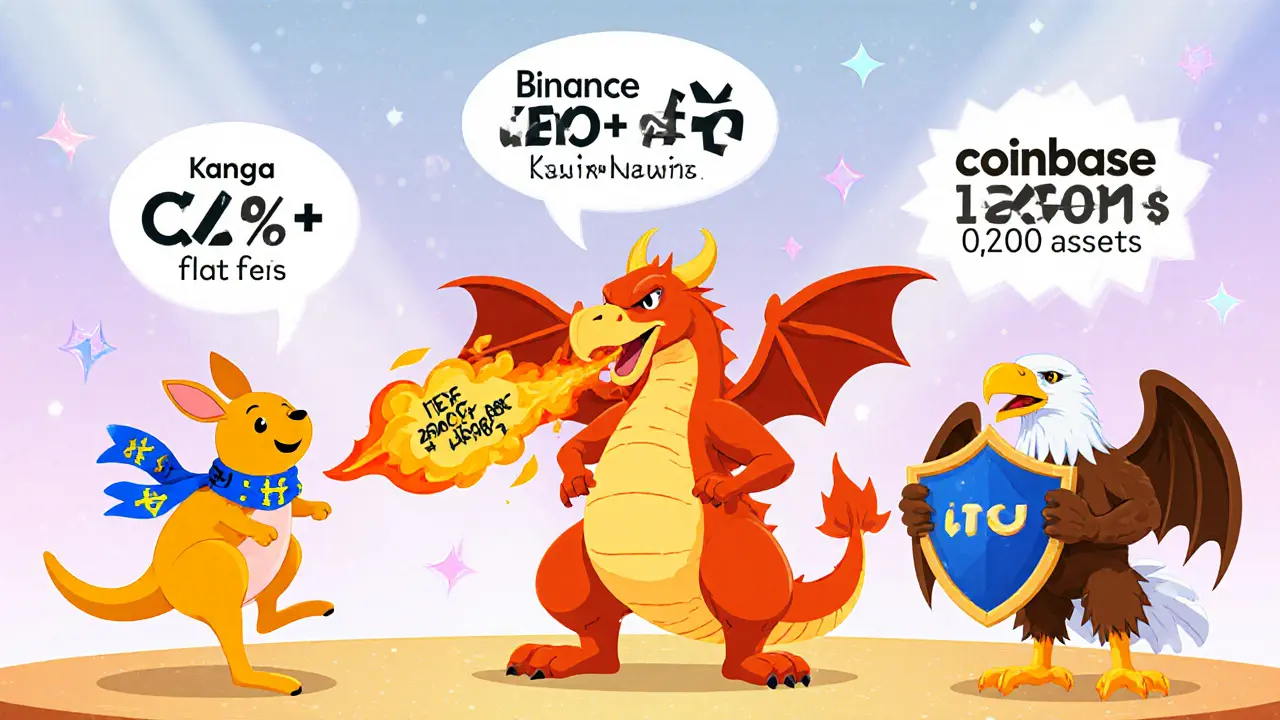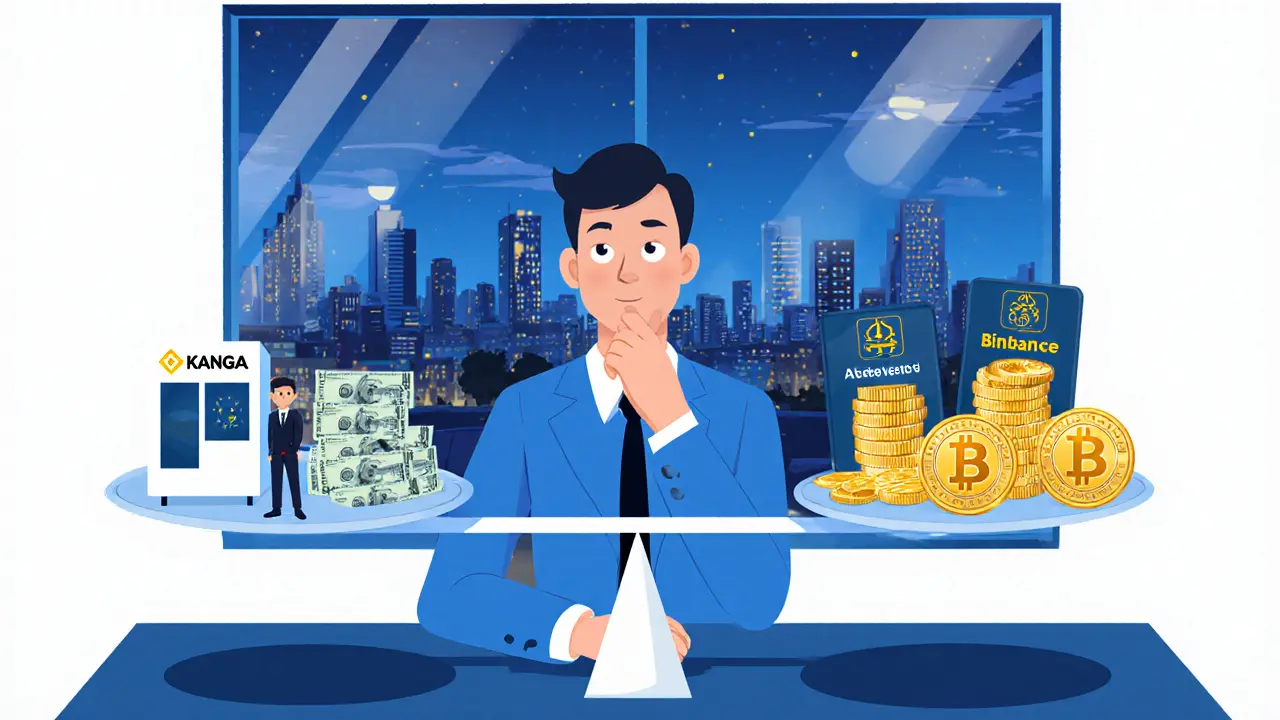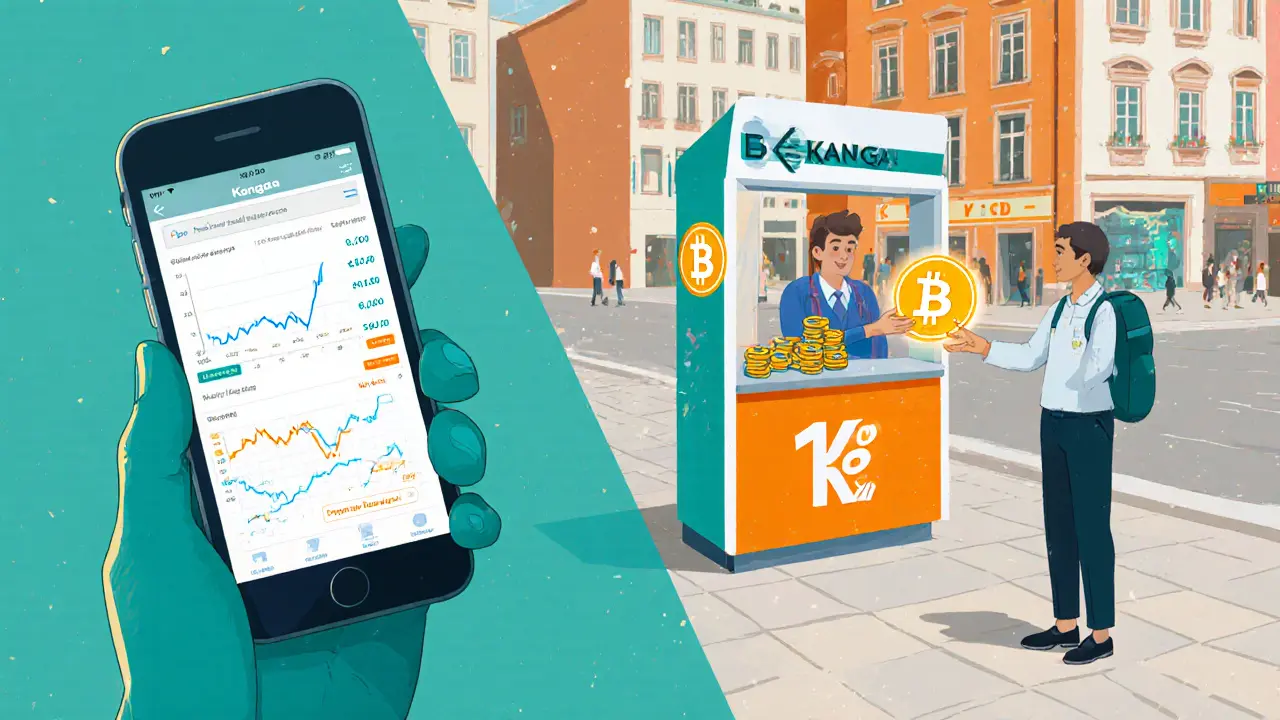Kanga Exchange Feature Comparison Tool
Feature Comparison: Kanga Exchange vs. Binance vs. Coinbase
| Feature | Kanga Exchange | Binance | Coinbase |
|---|---|---|---|
| Supported crypto assets | 140+ | 1,200+ | 600+ |
| Trading pairs | 200+ | 1,000+ | 400+ |
| Futures leverage | Up to 100× | Up to 125× | None (spot only) |
| OTC physical locations | 250+ in 12+ countries | None | None |
| Trading fee (maker/taker) | 0.2% flat | 0.1%-0.2% tiered | 0.5%-0.0% tiered |
| Trustpilot rating | 2.8/5 | 4.3/5 | 4.1/5 |
| Regulatory license | Seychelles + Polish authority | Various (Malta, US, etc.) | US + EU licenses |
Key Insights
- Kanga's biggest advantage is its hybrid digital + physical model, offering 250+ OTC cash-to-crypto points across Europe.
- Its flat 0.2% fee is simple and transparent, competing well with tiered fee structures.
- While Kanga has up to 100× futures leverage, it trails Binance's 125× leverage.
- With only 200+ trading pairs, Kanga is less comprehensive than Binance's 1,000+ pairs.
- Customer support ratings are lower than Binance and Coinbase, with a 2.8/5 Trustpilot score.
Who Should Use This Comparison?
Use this tool to evaluate whether Kanga Exchange aligns with your trading needs. Consider the following questions:
- Do you prioritize physical cash-to-crypto access in Europe?
- Are you comfortable with limited trading pairs and modest liquidity?
- Do you prefer a flat fee structure over tiered fees?
- Is a regulated European exchange important for compliance reasons?
Quick Take
- Poland‑based Kanga Exchange offers a hybrid digital‑plus‑physical trading model.
- Supports 140+ crypto assets, 200+ pairs, and up to 100× futures leverage.
- Trading fees stay flat at 0.2%; withdrawals carry a small network fee.
- Hybrid model gives you access to 250+ OTC cash‑to‑crypto points across Europe.
- Trustpilot score is 2.8/5 - lower than Binance, Coinbase, or Kraken.
What is Kanga Exchange?
Kanga Exchange is a Poland‑based cryptocurrency trading platform founded in September 2018. The founders, led by Slawomir Zawadzki, wanted a service that works for both retail traders and institutions, so they combined a web‑based interface, mobile apps, and a network of physical cash‑to‑crypto points. The exchange is licensed by the Republic of Seychelles and is also backed by the Polish Financial Supervision Authority, giving it a regulatory veneer that many pure‑play crypto desks lack.
How to Get Started
Signing up is straightforward. You create an account on the web portal or download the iOS/Android app, then upload a government‑issued ID and proof of address. Most European users see their KYC cleared within 24‑48hours. After verification you can fund the account with a PLN, USD, or EUR bank transfer, or simply deposit crypto - the latter is fee‑free.
Deposits as low as PLN100 (about $25) are accepted, making the entry barrier modest for beginners. Once the balance is live, you can start spotting, place limit or market orders, or explore the futures market.
Core Features
The platform offers three main trading modes:
- Spot trading - over 140 cryptocurrencies and 200+ pairs are available. Real‑time charts and a clean order‑book are built into the web UI.
- Futures trading - you can trade with up to 100× leverage on a select set of popular assets. The 2025 mobile‑app update (v1.26.0) added futures charts and margin controls.
- Staking & IEOs - the native KNG token lets you earn staking rewards, and the exchange periodically runs Initial Exchange Offerings for new projects.
What truly sets Kanga apart is its OTC network. With more than 250 brick‑and‑mortar points in 12+ countries, you can walk into a shop, hand over cash, and walk out with Bitcoin - a convenience that’s rare among global rivals.
Fees and Limits
Trading fees are a flat 0.2% on both maker and taker sides, which is competitive for a regulated exchange. There are no deposit fees for crypto, and fiat deposits via SEPA are free. Withdrawal fees vary by coin - for example, Bitcoin withdrawals cost 0.0004BTC, while ERC‑20 tokens cost $2.70 on average. The minimum withdrawal amount mirrors the fee, preventing tiny dust withdrawals.
If you trade futures, the same 0.2% fee applies, but you’ll also pay a funding rate that flips every eight hours. The platform caps leverage at 100×, matching industry peers like ByBit and BitMEX.

Security and Compliance
Kanga implements two‑factor authentication (2FA) for every login, and all funds are stored in multi‑chain wallets with cold‑storage vaults for the majority of assets. Because the exchange holds a Seychelles license and is overseen by the Polish Financial Supervision Authority, it must follow AML/KYC standards comparable to EU banks.
However, the platform’s Trustpilot rating of 2.8/5 signals that users have encountered support delays and occasional downtime during high‑volume spikes. For risk‑averse traders, the security stack is solid, but the customer‑service experience lags behind the major players.
Strengths vs. Weaknesses
Pros
- Hybrid digital+physical model makes cash‑to‑crypto easy in Europe.
- Flat 0.2% fee is simple and transparent.
- Regulated environment adds a layer of trust for institutional users.
- Mobile app now supports futures trading, closing a major feature gap.
Cons
- Liquidity is modest compared to tier‑1 exchanges - price slippage can appear on larger orders.
- Only 200+ trading pairs, while Binance lists over 1,000.
- Missing advanced tools like copy‑trading, NFT marketplace, and deep research widgets.
- Customer‑service response times are slower, reflected in the low Trustpilot score.
How Kanga Stacks Up Against the Big Guys
| Feature | Kanga Exchange | Binance | Coinbase |
|---|---|---|---|
| Supported crypto assets | 140+ | 1,200+ | 600+ |
| Trading pairs | 200+ | 1,000+ | 400+ |
| Futures leverage | Up to 100× | Up to 125× | None (spot only) |
| OTC physical locations | 250+ in 12+ countries | None | None |
| Trading fee (maker/taker) | 0.2% flat | 0.1%‑0.2% tiered | 0.5%‑0.0% tiered |
| Trustpilot rating | 2.8/5 | 4.3/5 | 4.1/5 |
| Regulatory license | Seychelles + Polish authority | Various (Malta, US, etc.) | US + EU licenses |
The table shows that Kanga’s biggest advantage is the physical OTC network, but it trails on liquidity, asset breadth, and brand trust.
Real‑World User Experience
App‑store reviews praise the Kanga wallet for its clean layout - users call it “the first simple and easy to use app for crypto”. On the flip side, a recurring complaint is that limit orders can’t be edited or cancelled from the mobile app, forcing traders to jump to the web UI.
Customer‑service tickets on Trustpilot often mention slow email replies and occasional downtime during market spikes. Reddit threads in European crypto groups highlight the physical locations as a lifesaver for newcomers who only have cash on hand.
Who Should Consider Kanga?
If you live in Poland, the Czech Republic, or neighboring EU states and need a place to turn cash into Bitcoin without a bank, Kanga’s OTC spots are a clear win. Institutional clients that value a regulated European entity for compliance will also find the exchange appealing.
Conversely, day‑traders chasing deep liquidity, advanced charting, or a wide selection of altcoins will probably feel constrained and might prefer Binance or Kraken.
Final Verdict
Kanga Exchange carves a niche by blending digital trading with a real‑world cash‑to‑crypto network. Its flat 0.2% fee, 100× futures leverage, and regulatory backing make it a solid choice for European users who value physical access points. However, low liquidity, a modest asset list, and a subpar support rating mean it’s not the go‑to platform for high‑frequency traders or global investors seeking the deepest order books.
In short, think of Kanga as the “local bank” of crypto - reliable for everyday transactions, but not the “Wall Street” of crypto trading.

Frequently Asked Questions
Is Kanga Exchange regulated?
Yes. Kanga holds a license from the Republic of Seychelles and operates under the oversight of the Polish Financial Supervision Authority, which requires AML/KYC compliance.
What fiat currencies can I deposit?
Polish złoty (PLN), US dollars (USD) and euros (EUR) are accepted via bank transfer. Credit‑card deposits are also supported for select currencies.
How does the OTC network work?
Kanga partners with local storefronts across Europe. You show a valid ID, hand over cash, and the agent initiates a crypto transfer to your Kanga wallet. The service is useful where bank transfers are slow or unavailable.
Can I trade futures on the mobile app?
Yes. The 2025 app update (v1.26.0) added futures charts, margin controls, and order‑type selection for leveraged trading.
Why is the Trustpilot rating low?
Users frequently mention slow support response times and occasional platform instability during peak volumes. Those issues have kept the rating around 2.8/5.


I’ve been digging into Kanga’s paperwork and something feels off – the dual licensing from Seychelles and a Polish regulator looks like a classic “hide‑in‑plain‑sight” move to dodge stricter EU oversight. They push the hybrid cash‑to‑crypto model as a convenience, but it also gives them a physical foothold to launder cash under the radar. And that flat 0.2% fee? Too neat, like they’re trying to lure high‑volume traders into a funnel that feeds a hidden reserve.
Hey folks, great rundown! The flat‑fee structure definitely lowers the barrier for newcomers, and the OTC locations are a sweet spot for anyone still juggling cash and crypto. It’s also nice to see a regulated European player stepping into the space – that could set a new standard for compliance. Keep the insights coming! :)
Kanga’s hybrid model is an interesting compromise between pure digital exchanges and traditional finance.
By offering over 250 physical cash‑to‑crypto spots, they solve the “cash problem” that many European newbies face.
The flat 0.2% maker‑taker fee is refreshingly simple compared to the tiered structures on Binance.
For small‑scale traders, that simplicity can translate into predictable costs.
Their support for 140+ assets and 200+ pairs is modest, but it covers the major coins most users need.
Liquidity, however, is where the platform shows its limits – order books can be thin, leading to slippage on larger orders.
The 100× futures leverage is competitive, yet risk‑adjusted returns still favor larger venues with deeper markets.
Regulatory backing from Seychelles and the Polish authority does add a layer of confidence, especially for institutional partners.
Nonetheless, the low Trustpilot score of 2.8/5 signals that customer service is an area needing improvement.
Users have reported delayed ticket responses and occasional downtime during market spikes.
From a security standpoint, two‑factor authentication and cold‑storage vaults are standard, which is reassuring.
The mobile app’s recent futures upgrade shows the team is actively iterating on product features.
Yet the lack of advanced tools like copy‑trading or in‑app research widgets may deter power traders.
Overall, Kanga feels like a “local bank” for crypto – solid for everyday transactions but not a “Wall Street” hub.
If you value physical access points and a straightforward fee schedule, it’s worth a look; otherwise, the big players still dominate the deep‑liquidity game.
The market microstructure on Kanga is fundamentally constrained by its shallow order‑book depth, resulting in a sub‑optimal execution environment. Their fee model, while flat, does not compensate for the adverse selection risk inherent in low‑liquidity venues. Moreover, the absence of a robust API throttling mechanism raises concerns about algorithmic trading stability. In short, the platform’s architecture is more suited for retail dabblers than professional quant desks.
I’ve actually tried the OTC spots in Warsaw, and the staff were super helpful. The process was quick – hand over cash, get the crypto, and you’re done. It’s definitely a nice bridge for people who aren’t comfortable with bank transfers.
Flat fee, simple, regulated – it works!
When you look at the fee schedule, the 0.2% flat rate is a double‑edged sword; it removes tiered complexity, true, yet it also ignores volume‑based incentives that heavy traders rely on for cost optimization. The limited asset list, while covering the market leaders, excludes niche tokens that could attract diversified portfolios, thereby narrowing the user base. Their OTC network, though innovative, adds operational overhead that could be better allocated toward improving order‑book depth, which in turn would reduce slippage and attract higher‑frequency traders. Furthermore, the platform’s compliance framework, while reassuring on paper, may become a bottleneck in jurisdictions demanding real‑time KYC verification, slowing down onboarding. In essence, Kanga offers a solid foundation for beginner to intermediate users, but it needs significant feature augmentation to compete with the liquidity‑heavy giants.
Honestly, the whole thing feels like a gimmick – a flat fee can’t hide the fact that you’re trading on a thin market. If you’re looking for real depth, you’re better off staying on the big exchanges.
For anyone considering Kanga, keep an eye on the withdrawal fees per coin – they can add up, especially on lower‑priced assets. Also, the SEPA deposits are free, which is a nice perk for European users.
i think the otc point is a nice nice feature, but the platform still lacks the deep liquidity needed for large trade. also, some UI bugss can be seen on the mobile app sometimes.
While the dramatic claims of a hidden agenda are tempting, the dual‑licensing model actually aligns Kanga with international AML standards. The transparency of the 0.2% fee, combined with European regulatory oversight, should allay most compliance concerns. :)
Oh sure, another “expert” telling us the market microstructure is broken – because we all know the real problem is the users who can’t handle any price movement. Maybe if you tried a platform that actually works, you’d stop whining.
Good points about the fee simplicity. One thing to add: the exchange’s API documentation has improved recently, making it easier for developers to integrate trading bots. This could gradually attract more algorithmic traders, boosting liquidity over time.
Exactly! A better API can be a game‑changer. If the dev community starts building tools around Kanga, we’ll likely see a virtuous cycle of increased usage and tighter spreads. Let’s keep an eye on their developer portal updates.
From an ethical standpoint, promoting a platform with a sub‑par Trustpilot rating feels irresponsible. Users deserve transparent support and reliable service; otherwise, we’re merely encouraging them into a potentially risky environment.
In summary, Kanga offers a niche solution for European cash‑to‑crypto conversions with a clear fee structure, yet its limited liquidity and support issues may constrain more advanced traders. Prospective users should weigh these factors against their specific trading requirements.